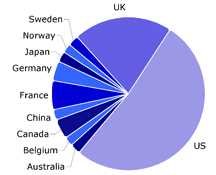For a while, it seemed that every conversation about companies interacting with bloggers fell back on the same few anecdotes. It was as if our economy were based on Dell and Kryptonite. For better or worse, that's changed now. We're seeing more examples of bloggers calling out companies, and all too often, the companies don't understand the culture. Today it's the National Pork Board.
 Jennifer Laycock is a work-at-home mom and founder of The Lactivist, "a site that aims to promote breastfeeding through humor." One of her activities is selling shirts with funny slogans at CafePress, and one of her designs—The Other White Milk—was too close to The Other White Meat® for the eat-more-pig crowd.
Jennifer Laycock is a work-at-home mom and founder of The Lactivist, "a site that aims to promote breastfeeding through humor." One of her activities is selling shirts with funny slogans at CafePress, and one of her designs—The Other White Milk—was too close to The Other White Meat® for the eat-more-pig crowd.
We understand the need to defend trademarks, but the Pork Board skipped a step and went straight to the threatening letter (PDF). Look at Jennifer's complaint:
Now let me make one important point. I don't much care about selling the shirt. In fact, CafePress had removed it from the site before I ever even saw the letter from the law firm. It really doesn't matter to me if I ever sell it again. It's certainly not the cleverest slogan I've come up with so it's no big loss. What I'm ticked about is that rather than taking two seconds to send me a nice email to request that I remove it, they came in guns a blazin' with a lawyer crafted nasty gram that actually includes the phrase "We trust that after you have reviewed this matter, you will conclude that the better course is to promptly comply with National Pork Board's demands herein."
I don't have a lot of tolerance for bullies.
I still have a few days to decide what I'm going to do. Anyone know a good pro bono lawyer that's sympathetic to the breastfeeding cause?
Try being niceWhere a
personal note might have resolved the issue to the Board's satisfaction, a C&D has Jennifer thinking of fighting for a design that even she says isn't her best work.
There's a great summary I've seen too many times to attribute: Social media are about people. We tend to be more casual and personal here, so when you can, try a casual and personal approach. There must be some way you can ask nicely while preserving the ability to get nasty if that doesn't work.
Choose your battles
The popular perception of a fight like this is easy to predict. They're messing with Motherhood. How's roast pork with Apple Pie, anyway?
Just to make this more interesting, Jennifer's also the editor of Search Engine Guide, which means she hangs out with people who change search engine results for a living. As a result of this incident, her post is likely to rank well for "National Pork Board," since other search marketing bloggers are picking up the story.
The story, by the way, is "national trade group picks on advocate for mothers' milk." And a few people have seen it—remember, this happened today.
It's been Dugg.
It's on Reddit
It's on Netscape
It's on The Small Business Ideas forum.
It's on Marketing Pilgrim
It's on Traffick
It's on Breastfeeding 1-2-3
It's on Search Engine Land
It's on Shoemoney
It's on Search Engine Guide
It's on The Feeding Choices Board at BabyCenter
It's on I don't Know
All because they didn't ask nicely.
Social media are about people. People with their own presses and empathetic audiences. Try engaging the person before you send the attack dogs; you might get what you want if you just ask.
Update: They apologized. Matt Bailey has an insightful view into how blogs and citizen marketers change the environment for these disputes.
Update2: The last word.
Tags: SERM bloggers motherhood PR
 In the process of developing the Guide to Social Media Analysis, I've found 48 companies in 11 countries so far (Australia, Belgium, Canada, China, France, Germany, Japan, Norway, Sweden, United Kingdom, United States). I'm referring to the headquarters locations here; some of these companies are multi-national, and their staffs are frequently international, too.
In the process of developing the Guide to Social Media Analysis, I've found 48 companies in 11 countries so far (Australia, Belgium, Canada, China, France, Germany, Japan, Norway, Sweden, United Kingdom, United States). I'm referring to the headquarters locations here; some of these companies are multi-national, and their staffs are frequently international, too.

 Students of PR are
Students of PR are 

